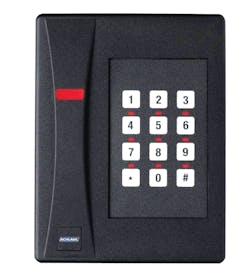Locksmiths can help their customers and themselves by proposing multi-technology readers that combine the ability to read multiple credentials. In today’s more secure-conscious world, security professionals know that, oftentimes, it is not good enough to base access control on a single PIN or card. PINs can be used by others as can cards. However, the likelihood of a bad guy knowing the PIN of the person whose card they have found or stolen, is not that good.
There are three ways to verify a person’s identity:
- What they know – a PIN;
- What they have – a card; and
- Who they are – a biometric.
Using any combination of the three provides more assurance that the right person is gaining access: PIN plus smartcard, proximity card, magnetic stripe card or biometric as well as card type plus biometric. Readers are available for any combination. For instance, the University of Virginia uses a two-step authorization process of a PIN and magnetic stripe reader using Schlage AD-400 wireless locks.
“No longer, if someone finds an ID card, can they simply go to the reader, swipe it and get in,” emphasizes Gary Conley, University of Virginia, facilities & systems sngineer, Office of Business Operations – Charlottesville, Va. “With the AD-Series dual credential locks, they also need to know the PIN. Dual factor authentication will stop these unauthorized individuals from getting into a student’s room.”
For those using biometric readers, the two-step process is basically a built-in commodity. The person either enters a PIN or swipes a card at the biometric reader to bring up the biometric template of the hand. The hand is laid on the platen and, if the templates match, the person enters.
Business Opportunity – Smart Cards
Today, the cost of a smart card is comparable to that of the standard, traditional proximity card, which is the most used card in physical access control today. Yet, it provides much higher security than a proximity card along with the ability to handle a wide variety of applications from holding biometric templates to being used for cashless vending. Thus, the comparable cost alone removes a major impediment to the use of smart cards. It is important that all organizations be prepared for smart credential deployment, even if that facility wants to install proximity at present.
Multi-credential readers are perfect for these customers. Besides aiding implementation, multi-technology readers are available to create flexibility in the transition while allowing companies to leverage the lower cost of smart cards.
With a multi-credential reader being installed at every new door, organizations are able to flexibly plan for the future. Since multi-technology readers work on both the proximity frequency and the smart card frequency, customers can still use their current proximity credentials while migrating to smart credentials at their own pace.
Emphasize how, during the transition, they can use both their old credential and the new smart credential. Your customer can upgrade on their preferred timelines, not due to the whim of technology that forces a "now or never" alternative. When their switch to smart cards comes about, they will not have to tear out and re-install all of their facilities’ readers.
Smart Cards & Biometrics
Smart cards used with biometrics raises the security level. That’s because a single smart card can store both the user’s ID number and biometric template. Because of this, there is no need to distribute hand templates across a network of readers or require the access control system to manage biometric templates. This means integration to any existing access control application is greatly simplified, eliminating extra network infrastructure costs. Because the template only resides on the card, the solution also eases individual privacy concerns.
Providing the best of smart cards and biometrics, the solution provides dual authentication by requesting both the right card and the right person. A smart card reader is attached to or embedded into the biometric reader. A plastic cardholder is affixed to the side of the unit. The verification process takes approximately one second.
With the hand reader, the hand template requires only nine bytes to define the hand, the smallest in the biometric industry. This ensures that response times are fast and that the smart card can maximize its benefits by offering users increased room for other applications.
Multi-Credential Readers
Multi-technology readers aid integrators in more ways than simply showing customers how they can create a planned program for introducing smart cards. Remember, a multi-technology reader reads both smart cards and proximity cards. Thus, for an investment of about 10 percent more, you can reduce your number of SKUs by carrying only one reader, one that reads both technologies.
Secondly, since a Schlage multi-technology reader reads Schlage card formats plus the formats of many other popular brands, you can reduce the number of vendors you carry, increasing shelf space and again reducing SKUs. Lastly, carrying a multi-technology reader in the service vehicle helps your technicians maximize space and helps them service a very large percentage of the reader population with only one reader.
Jeremy Earles is Ingersoll Rand Security Technologies’ portfolio manager, credentials & readers






